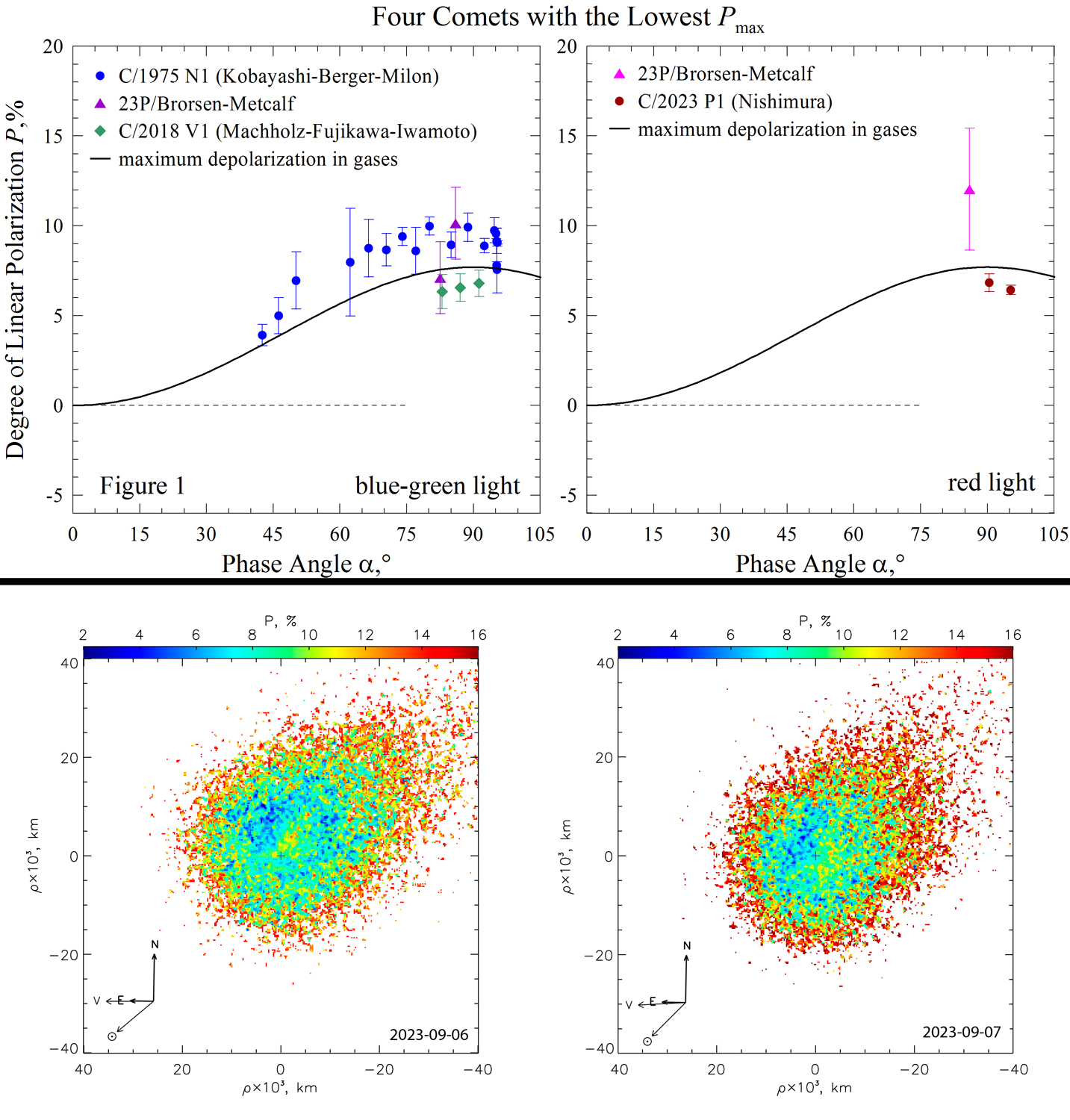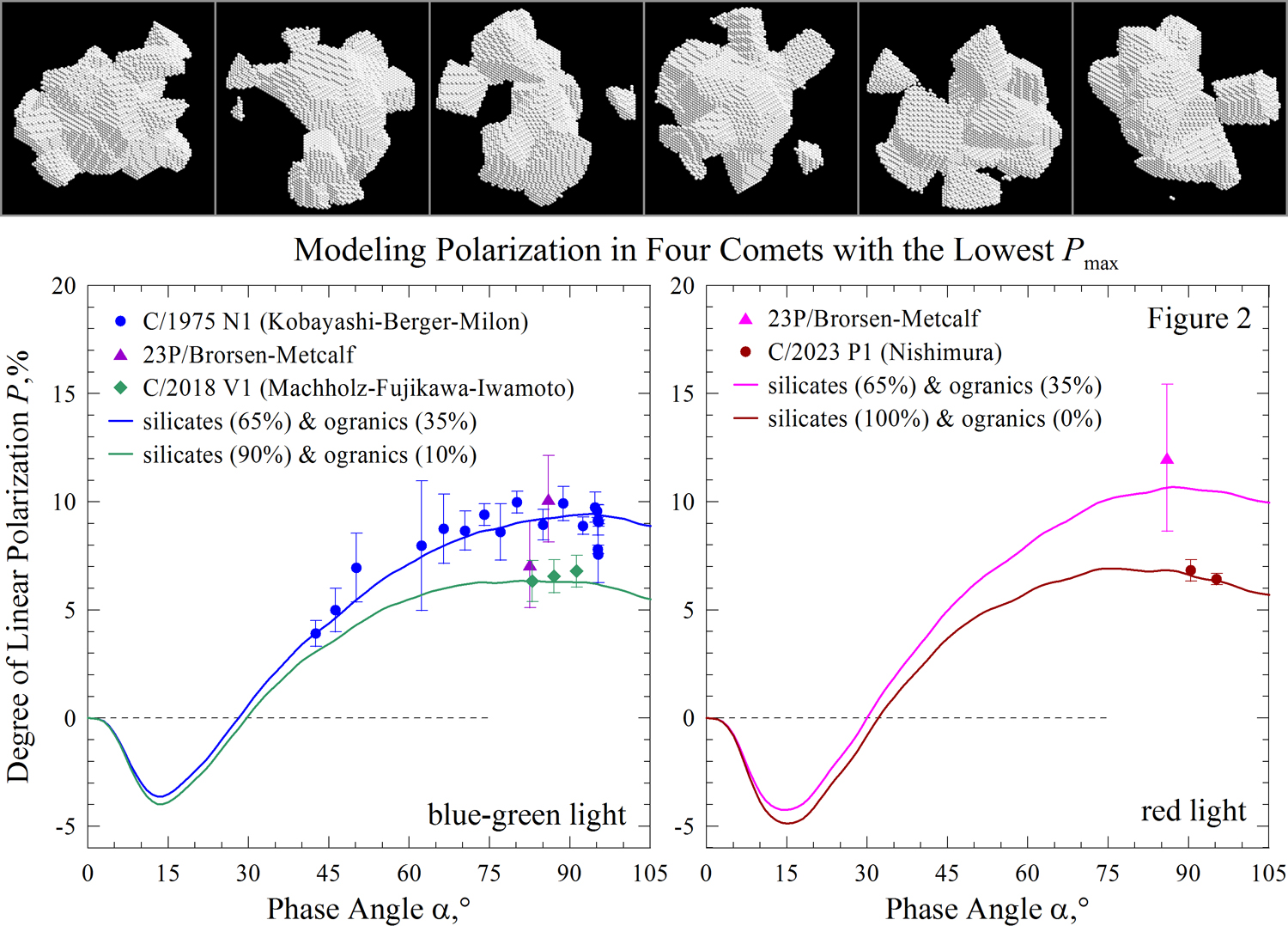Comets with extremely low positive polarization
- 1Institute for Basic Science (IBS), Planetary Atmospheres Group, Korea, Republic of (evgenij.s.zubko@gmail.com)
- 2Institute of Applied Astronomy, Russian Academy of Science, Russia
- 3Space Science Institute, CO, USA (gorden.videen@gmail.com)
Polarimetric observations of comets reveal that sunlight scattered from their comae acquires partial linear polarization that can be quantified with the degree of linear polarization P = (F⊥ – F)/(F⊥ + F). Here F⊥ and F correspond to fluxes of the scattered light measured with the polarizing filter (analyzer) oriented perpendicular to the scattering plane and parallel to the scattering plane, respectively (Zubko & Videen 2023 for review). P is dependent on the geometry of illumination and observation, which is described with the phase angle α. In comets, the phase-angle dependence of polarization reveals two stable features. At small phase angles (α < 25°), nearly all comets reveal the phenomenon of negative polarization (i.e., F⊥ < F), and at larger phase angles, their polarization is positive (i.e., F⊥ > F). In both domains, the angular dependence of polarization appears in the form of a bell-like branch. The amplitude of the negative-polarization branch is characterized with the minimum polarization Pmin and phase angle where this minimum occurs αmin. Correspondingly, the positive polarization branch is described by Pmax and αmax.
Observations of comets demonstrate a significant difference in their polarimetric responses. This dispersion appears most noticeably in the amplitude of the positive-polarization branch with Pmax spanning the range from ~6% up to ~35% (Zubko & Videen 2023 for review). It is worth noting a disparity exists between the numbers of comets with high and low maximum of polarization Pmax. While at least several dozens comets with Pmax > 20% have been detected with confidence, only four comets having Pmax < 10% have been reported. Interestingly, two comets with extremely low Pmax, C/1975 N1 (Kobayashi–Berger–Milon) and 23P/Brorsen–Metcalf, were observed in 1975 and 1989, respectively (Chernova et al. 1993). Then, comets of this kind were not seen for almost thirty years, until Comet C/2018 V1 (Machholz-Fujikawa-Iwamoto) (Zubko et al. 2020). The latest comet with extremely low Pmax, C/2023 P1 (Nishimura) was the first one investigated by means of imaging polarimetry (Zheltobryukhov et al. 2024). The top panels in Figure 1 show the degree of linear polarization as a function of phase angle in the low-Pmax comets observed in green-blue light (left) and in the red light (right). The bottom panels in Figure 1 show polarimetric images of Comet C/2023 P1 (Nishimura) as they were reported by Zheltobryukhov et al. (2024).

Öhman (1941) put forth a tentative explanation of the dispersion of Pmax that is based on the depolarization effect of gaseous emissions. Within the Öhman’s concept, comets with low Pmax were assumed to be rich in gas; whereas, high Pmax was attributed to comets rich in dust. This hypothesis was adapted by Chernova et al (1993) and it was further pursued by Kolokolova et al. (2007). Nevertheless, at the time of publication by Chernova et al., there was evidence that the low-Pmax comets are dust rich. Near-IR and mid-IR photometry demonstrated that C/1975 N1 (Kobayashi–Berger–Milon) and 27P/Crommelin are dust-rich comets, for instance (Ney 1982 and Krishna Swamy 1991, respectively). Zubko et al. (2016) demonstrated that the gaseous hypothesis cannot reproduce the location of the polarization maximum in the low-Pmax comets. While observations reveal αmax = (80 ± 10)°, the gaseous emissions of any kind must yield αmax = 90°. Furthermore, the gaseous explanation cannot produce negative polarization (i.e., Pmin = 0), whose absence has never been observed in comets (Zubko et al. 2016). The observations of Comet C/2023 P1 (Nishimura) are not compatible with the gaseous hypothesis; e.g., the aperture-average polarimetry and imaging polarimetry of this comet, both reveal polarization noticeably lower than what could emerge from gaseous emissions of any kind, i.e., 7.7% at α = 90° (see Figure 1).
An alternative explanation for dispersion of Pmax in comets was suggested by Zubko et al. (2016) based on numerical simulation of light scattering by irregularly shaped agglomerated debris particles (see six examples of top in Figure 2). This approach suggests that the cometary coma is composed of at least two types of dust, whose refractive indices correspond to the Mg-rich silicates and carbonaceous material (organics and/or amorphous carbon). A mixture of these two components can satisfactorily reproduce the polarimetric observations of comets with different Pmax simultaneously at several wavelengths by varying only the volume ratio of silicate and carbonaceous materials (see Zubko et al. 2016 for further details). As shown in the bottom of Figure 2, the same approach can fit the observations of the latest comets with extremely low Pmax. Note, the radius of the agglomerated debris particles of both compositions spans the same range from r ≈ 0.08 μm up to 3.7 μm. Their light-scattering responses are averaged with a power-law size distribution with index n = 2.2. The relative abundance of the two components (by volume) is given in the legend of Figure 2. As one can see, the two-component model fits observations of the low-Pmax comets suggesting domination of weakly absorbing Mg-rich silicate particles in their coma. This finding appears in good agreement with cold dust detected in C/1975 N1 (Kobayashi–Berger–Milon) by means of mid-IR photometry (Ney 1982).

References
Chernova G.P., et al., 1993, Icarus, 103, 144
Krishna Swamy K.S., 1991, Astron. Astrophys., 241, 260
Kolokolova L., et al., 2007, Astron. Astrophys., 463, 1189
Ney E.P. 1982, in L.L. Wilkening, ed., Comets. University of Arizona Press, Tucson, AZ, p. 323
Öhman Y., 1941, Stockholms Obs. Ann. 13, 11.1–11.20.
Zheltobryukhov M., et al., 2024, Mon. Not. Roy. Astron. Soc.: Lett., 528, L117
Zubko E., Videen G., 2023, in M.P. Mengüç and M. Francoeur, eds., Light, Plasmonics and Particles. Elsevier, Amsterdam, p. 327
Zubko E., et al., 2016, Planet. Space Sci., 123, 63
Zubko E., et al., 2020, Icarus, 336, 113453
How to cite: Zubko, E., Zheltobryukhov, M., Chornaya, E., Kochergin, A., and Videen, G.: Comets with extremely low positive polarization, Europlanet Science Congress 2024, Berlin, Germany, 8–13 Sep 2024, EPSC2024-343, https://doi.org/10.5194/epsc2024-343, 2024.